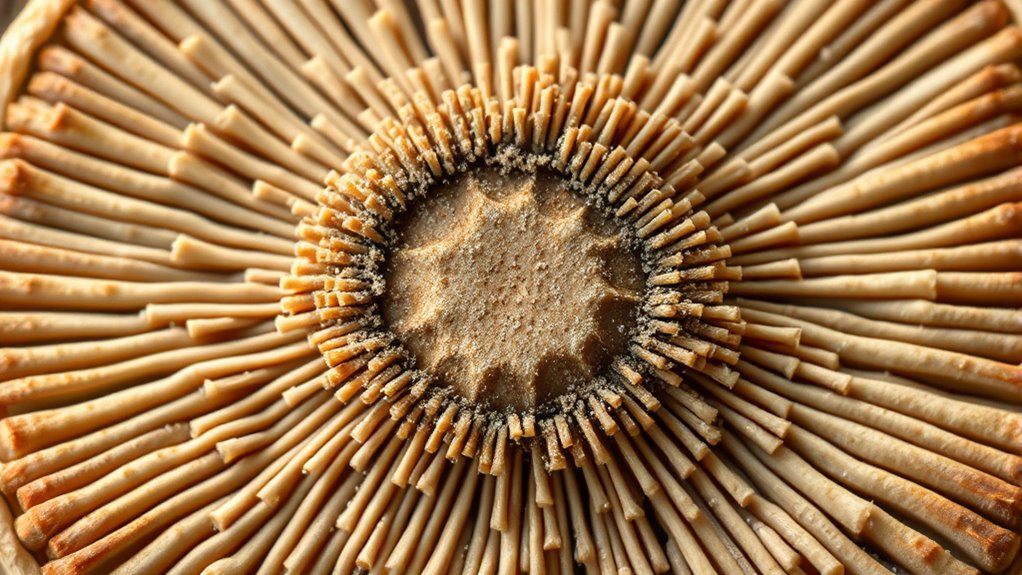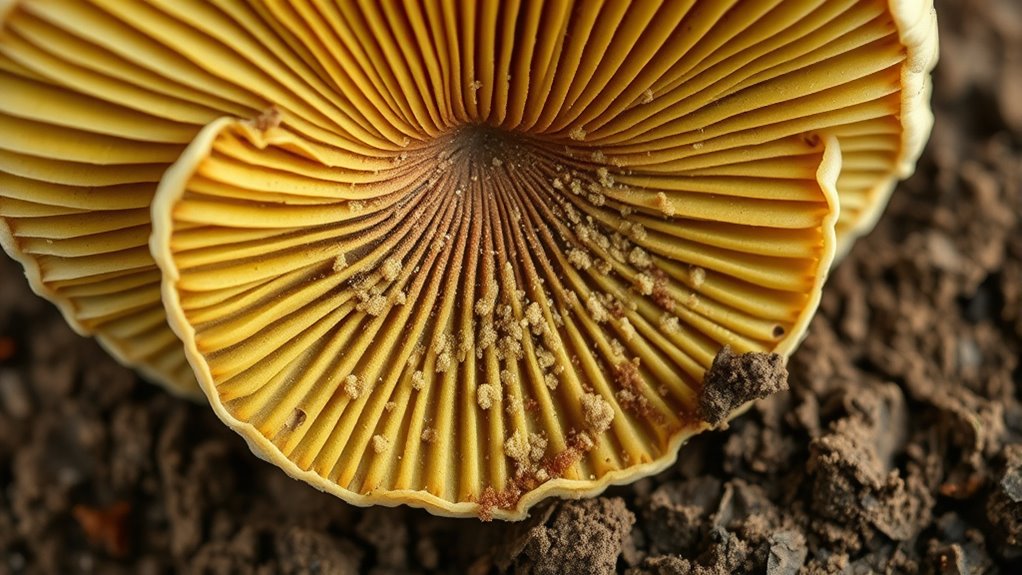To identify mushrooms reliably using the spore print, follow three easy steps: first, carefully set the mushroom cap, gills down, on a clean paper—white for dark spores, black for light spores—and cover it to prevent air disturbance. Next, let it sit undisturbed for several hours or overnight. Finally, observe the spore color carefully; a consistent hue helps distinguish edible from toxic species. Keep exploring to master these techniques for bulletproof mushroom identification.
Key Takeaways
- Collect the spore print by placing the mushroom cap gills down on a white or black paper, covering it to prevent air disturbance.
- Leave undisturbed for several hours or overnight to allow spores to fall and create a visible print.
- Observe the spore color carefully using a magnifying glass if needed, noting exact hue for reliable identification.
- Cross-reference the spore color with field guides, considering common colors like white, pink, brown, or black to differentiate species.
- Combine spore print results with other mushroom features (cap shape, gill attachment, habitat) for a bulletproof ID.

Have you ever wondered how to accurately identify mushrooms in the wild? One of the most reliable methods is examining the spore print, which reveals essential details about a mushroom’s species. Spore color is a key identification tip because it remains consistent within species and helps differentiate between edible, toxic, and uncertain varieties. To start, you’ll need a clean sheet of white or black paper, depending on the mushroom’s color, to make the spores stand out clearly. Carefully cut the stem at the base and place the cap, gills down, on the paper. Cover it with a cup or bowl to prevent air currents from disturbing the spores. Leave it undisturbed for several hours or overnight. When you lift the cap, you’ll see a spore print that displays the mushroom’s spore color, which becomes your primary identification tip.
The spore color can vary widely—from white and pink to dark brown or black—so it’s essential to note the hue accurately. Use a magnifying glass if needed to observe tiny details, and compare the print to a field guide or identification chart. Keep in mind that some mushrooms produce a white spore print, which is common among edible varieties like chanterelles, while others, like the deadly Amanitas, tend to have white or pale spores. Conversely, some toxic species produce dark brown or black spores, making this a key step in avoiding dangerous mistakes. The consistency of spore color within a species means that this simple test can save you from potentially lethal errors. Additionally, using proper spore print techniques ensures more accurate results and reduces the risk of misidentification.
In addition to observing the spore color, pay attention to other identification tips like cap shape, gill attachment, and habitat, but don’t underestimate the importance of spore print analysis. It’s often the clearest, most conclusive piece of evidence you can gather in the field. Be precise when recording your findings—note the exact shade of the spores, the time you took the print, and the conditions. This detailed observation helps when cross-referencing with trusted resources or consulting experts. Remember, mushroom identification can be tricky, so taking your time to perform a proper spore print and paying close attention to the spore color will markedly improve your chances of correctly identifying your wild mushrooms.
Frequently Asked Questions
Can Spore Prints Identify All Mushroom Species Accurately?
You might think spore prints can identify all mushroom species accurately, but they have limitations. While spore prints are useful for mushroom taxonomy, they don’t provide enough detail for precise identification of every species. Variations in spore color or environmental factors can mislead you. So, relying solely on spore prints isn’t foolproof; it’s best to combine them with other identification methods for accurate results.
What Are Common Mistakes to Avoid When Making Spore Prints?
Imagine you’re making a spore print when suddenly, spore contamination occurs because you didn’t cover it properly. Prevent improper timing by waiting too long or too short; spores may dry out or not develop fully. To avert mistakes, use clean tools, keep the print undisturbed, and remove debris promptly. This ensures accurate identification and avoids contamination that can mislead your mushroom analysis.
How Long Does It Take for a Spore Print to Develop?
You can expect a spore print to develop within 12 to 24 hours, depending on spore maturity and environmental influences. Factors like humidity, temperature, and air circulation can speed up or slow down the process. For the best results, keep the mushroom cap in a dark, stable environment. Check the print regularly, and you’ll see the spores change color and form a clear pattern as they mature.
Are There Safety Concerns When Handling Mushroom Spores?
Did you know some mushroom toxins can be present in spores? When handling spores, safety is essential because spores can disperse easily and may carry toxins or allergens. While most edible spores are safe, mishandling or accidental ingestion could cause allergic reactions or health issues. Always wear gloves, work in a well-ventilated area, and wash your hands thoroughly after handling spores to minimize risks of mushroom toxin exposure.
Can Spore Print Color Change Over Time or With Environmental Factors?
You might notice spore color variability over time or with environmental influence. Factors like humidity, light, and air exposure can cause spores to darken, fade, or change hue slightly. These environmental influences can alter the appearance of your spore print, but the core color remains a useful identification tool. Keep your spore prints in stable conditions to maintain consistent color, making it easier to identify your mushroom accurately.
Conclusion
Mastering the art of the spore print is like revealing the secret vault of mushroom identification! With just three simple steps, you hold the power to identify mushrooms faster than a speeding bullet, safer than a vault full of gold, and more accurate than a laser-guided missile. Once you get the hang of it, you’ll be the mushroom maestro everyone turns to—confident, unstoppable, and ready to conquer the wild mushroom world with just a print!









